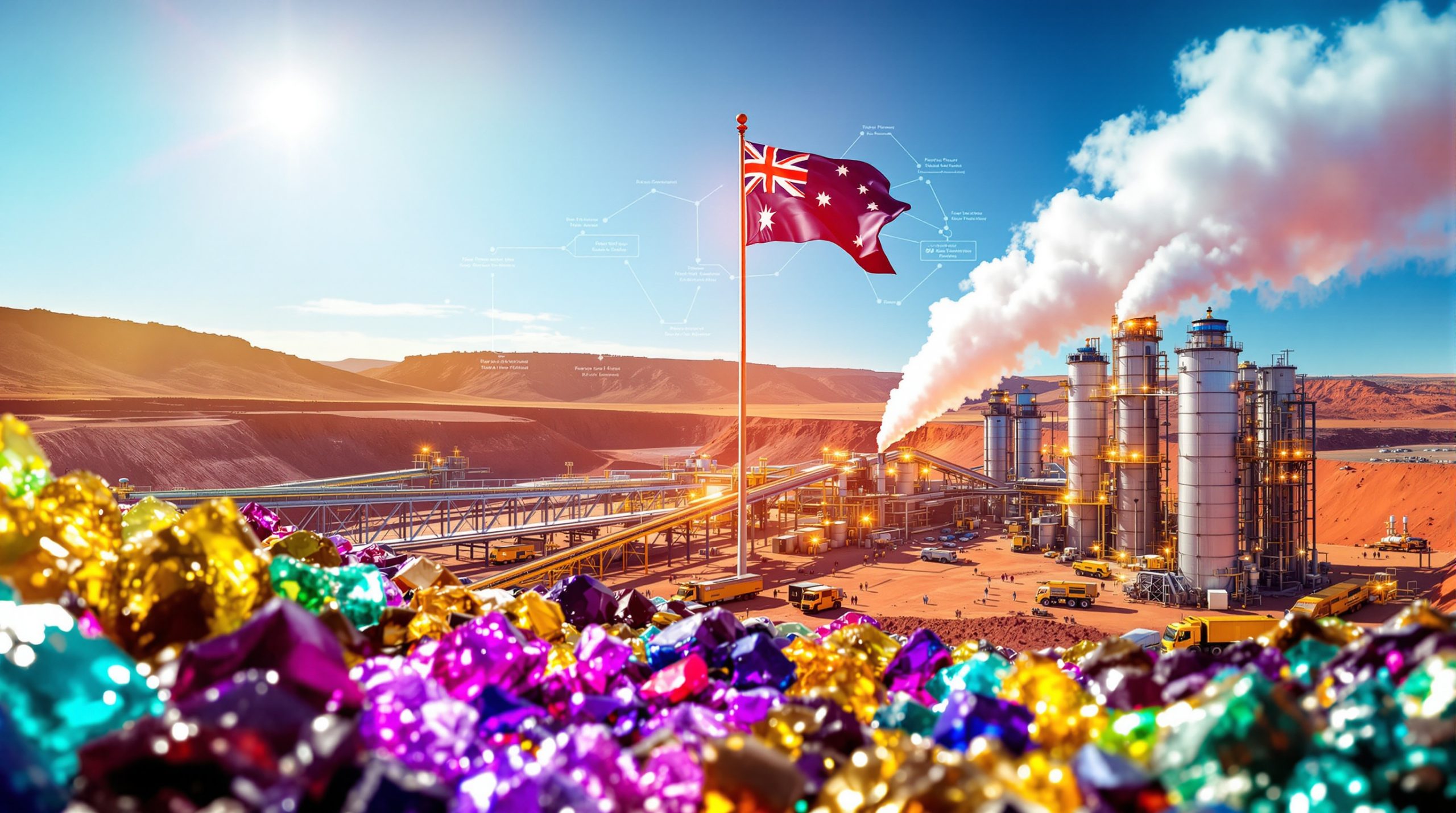Australia's rare earth refining sector is experiencing unprecedented transformation, evolving from a traditional raw material exporter to a sophisticated processing powerhouse. This strategic pivot addresses critical supply chain vulnerabilities while positioning the nation as a cornerstone of Western rare earth independence. The industry's rapid development reflects both abundant domestic resources and substantial government investment in downstream processing capabilities.
The transformation centers on breaking decades of Chinese processing dominance through integrated domestic facilities. Australia rare earth refining operations now encompass advanced separation technologies, strategic feedstock management, and comprehensive value-adding processes that extend far beyond simple concentrate production.
Current State of Rare Earth Processing Capabilities
Australia's refining landscape features several key facilities operating at different stages of development and technological sophistication. These operations demonstrate varying approaches to rare earth processing, from initial concentrate preparation to full separation into individual oxide products.
Table: Major Australian Rare Earth Refining Operations (2025)
| Facility | Location | Primary Output | Annual Capacity | Status |
|---|---|---|---|---|
| Eneabba Refinery | Western Australia | NdPr/Dy/Tb Oxides | 23,000 tpa potential | Under Construction |
| Kalgoorlie Processing Plant | Western Australia | Mixed REE Carbonate | 10,500 tpa | Operational |
| Nolans Project | Northern Territory | NdPr Concentrate | 4,400 tpa planned | Development Phase |
The Eneabba facility represents Australia's most ambitious processing investment, backed by substantial government financing and international engineering expertise. This facility will initially produce 5,500 tonnes per annum of neodymium-praseodymium oxide and 750 tonnes of dysprosium-terbium oxides, with potential expansion to 23,000 tonnes annually across multiple rare earth elements.
Strategic feedstock management underpins operational sustainability. Furthermore, Iluka Resources maintains a one-million-tonne feedstock stockpile at Eneabba, providing critical buffer capacity for long-term price stability and production continuity. This stockpile approach mitigates supply disruptions while enabling flexible processing schedules based on market conditions.
The processing capability encompasses both light and heavy rare earth elements, distinguishing Australian operations from facilities focused solely on abundant light elements. Additionally, the critical minerals energy transition highlights the importance of comprehensive approaches that address specific market gaps in heavy rare earth supply, where Chinese dominance remains most pronounced.
How Geographic Distribution Creates Strategic Advantages
Australia's rare earth deposits span multiple geological formations across different states, creating natural supply chain resilience that reduces single-point-of-failure risks. Western Australia dominates heavy rare earth potential through mineral sands operations, while Northern Territory projects contribute significant light rare earth resources.
This geographic distribution enables regional specialisation based on geological advantages. Western Australian operations leverage existing mineral sands infrastructure and expertise, reducing capital requirements for rare earth processing development. The state's established mining workforce and port facilities provide immediate operational advantages.
Northern Territory projects focus on hard rock rare earth deposits, offering different processing approaches and element compositions. This diversity strengthens overall supply security while enabling facility-specific optimisation for particular rare earth element profiles.
Transportation infrastructure connecting mining regions to processing facilities has evolved significantly to support increased domestic value-adding. Port facilities in Western Australia have expanded rare earth handling capabilities, while improved rail connections facilitate efficient concentrate movement between production sites and refineries.
The regional approach creates industrial clustering effects where shared infrastructure, skilled workforce, and technical expertise benefit multiple operations. This clustering reduces individual project costs while strengthening overall industry competitiveness against international processing centres.
Advanced Processing Technologies Driving Separation Excellence
Australian rare earth refining employs sophisticated separation techniques that maximise element recovery while minimising environmental impact. These technologies represent significant advances over traditional processing methods, incorporating closed-loop systems and selective chemical processes.
Key Processing Stages:
• Cracking: Breaking down rare earth minerals using controlled acid treatment processes
• Leaching: Dissolving target elements into solution through optimised chemical reactions
• Purification: Removing impurities through advanced filtration and precipitation techniques
• Solvent Extraction: Separating individual rare earth elements using selective chemical processes
• Product Finishing: Converting separated elements into high-purity commercial oxide forms
The Eneabba facility incorporates all processing stages within a single integrated complex. This comprehensive approach ensures quality control throughout the value chain while reducing transportation costs and processing delays between separation stages.
Solvent extraction systems utilise multiple processing circuits to achieve individual element separation from mixed rare earth solutions. These systems employ proprietary chemical processes that selectively bind specific rare earth elements, enabling sequential separation of individual products from complex feedstock materials.
Environmental sustainability drives technological innovation across Australian processing operations. Advanced water recycling systems minimise fresh water consumption while eliminating liquid waste streams. These closed-loop approaches position Australian refineries as environmentally responsible alternatives to traditional processing facilities.
Chemical recovery systems capture and reuse processing reagents, reducing both environmental impact and operating costs. This circular approach to chemical utilisation demonstrates sustainable processing practices while improving economic competitiveness against established international operations.
Leading Companies Shaping Australia's Refining Future
Iluka Resources has established the most comprehensive domestic refining strategy through its Eneabba facility development. The company combines existing mineral sands expertise with new rare earth processing capabilities, creating integrated operations that leverage established infrastructure and workforce capabilities.
The A$1.65 billion Australian Government non-recourse financing for Eneabba demonstrates unprecedented policy support for domestic processing development. This risk-sharing partnership between Iluka and government reduces private sector capital exposure while accelerating project timelines and technical execution.
Fluor Corporation serves as engineering, procurement, and construction management partner for Eneabba, bringing global expertise from Perth, Manila, New Delhi, and Johannesburg offices. This international partnership ensures access to specialised rare earth processing technologies while maintaining Australian project control and ownership.
Lindian Resources contributes high-quality feedstock through its Kangankunde project, described as one of the world's highest-quality undeveloped light rare earth deposits. The supply agreement with Eneabba creates structural alignment between premium ore bodies and advanced processing capabilities.
This partnership demonstrates how the critical minerals strategic reserve attracts international feedstock sources, positioning domestic facilities as regional processing hubs rather than purely domestic operations. The arrangement provides processing solutions that avoid Chinese facilities while de-risking commercialisation pathways for mining projects.
Lynas Rare Earths operates a hybrid processing model, combining Australian mining with international refining capabilities while developing expanded domestic processing capacity. Their Kalgoorlie operations handle initial processing stages, with plans for enhanced domestic separation capabilities as market conditions warrant expansion.
Arafura Rare Earths pursues vertically integrated operations through their Northern Territory Nolans project, combining mining and processing at single project sites. This approach reduces transportation costs while maintaining quality control throughout the value chain from mining to finished products.
Investment partnerships with allied nations create additional funding channels and technology transfer opportunities. These international collaborations strengthen Australia's position as a reliable supplier to Western supply chains while reducing geopolitical risks associated with traditional rare earth sources.
Global Production Capacity Comparisons and Market Positioning
Current Australian refining capacity represents approximately 3-5% of global rare earth processing capability, with significant expansion potential through planned project developments. This modest but growing market share positions Australia as an important alternative supplier rather than a dominant global force.
Global Refining Market Structure:
• China: Controls 85-90% of global rare earth separation capacity
• Malaysia: Processes 8-10% primarily through Lynas operations
• Australia: Manages 3-5% with rapid expansion underway
• Other Nations: Combine for 2-3% of total processing capacity
Planned Australian refining expansions could increase domestic processing capacity to 15-20% of global demand by 2030, depending on successful project execution and continued government support for downstream processing development. This growth trajectory positions Australia as a significant regional processing hub.
The expansion timeline varies considerably by project complexity and rare earth element focus. Light rare earth separation achieves commercial production faster than heavy rare earth processing, which requires more sophisticated separation techniques and specialised equipment configurations.
Australian facilities compete on processing quality and supply chain reliability rather than pure production volume. The emphasis on high-grade feedstock and advanced separation technologies creates premium positioning within global markets, particularly for applications requiring consistent element purity.
Market dynamics favour continued Australian expansion as global demand grows across electric vehicle, renewable energy, and defence applications. However, mining industry innovation and proximity to Asian manufacturing centres provides logistical advantages while offering supply chain diversification away from traditional sources.
Technical Challenges and Processing Complexities
Heavy rare earth element processing presents significant technical challenges due to similar chemical properties among elements like dysprosium and terbium. Australian refineries must develop specialised separation capabilities to efficiently process these premium-priced elements while maintaining economic viability.
Feedstock sourcing for heavy rare earth processing remains problematic, as most Australian deposits contain predominantly light rare earth elements. Processing facilities require flexible capabilities to handle varying rare earth compositions while maintaining consistent product quality across different feedstock sources.
Quality control systems must meet stringent end-user specifications for rare earth oxides, demanding consistent purity levels and minimal contamination across production runs. Automotive, electronics, and defence industry applications require certified product quality with extensive documentation and testing protocols.
Product certification processes add operational complexity while ensuring market acceptance of Australian rare earth products. Refineries must balance production efficiency with comprehensive quality assurance programmes to maintain customer confidence and long-term market access.
Processing flexibility enables facilities to handle diverse feedstock types while optimising production for market conditions. The ability to process both domestic Australian concentrates and international feedstock sources strengthens operational sustainability during market fluctuations.
Government Policy Framework Supporting Industry Development
The Australian Government's Critical Minerals Strategy identifies rare earths as essential for national security and economic development, creating comprehensive policy support for domestic processing expansion. This strategic framework includes direct financial support, favourable tax treatment, and regulatory streamlining for qualifying projects.
The A$1.65 billion non-recourse financing commitment to Iluka's Eneabba facility represents the largest government investment in rare earth processing development. Furthermore, the decarbonisation mining benefits demonstrate how this risk-sharing approach reduces private sector capital requirements while accelerating technical development and commercial deployment.
Export control mechanisms ensure domestic processing facilities receive priority access to Australian rare earth concentrates. These policies encourage value-adding while maintaining supply security for domestic industrial applications and strategic government requirements.
Regulatory streamlining reduces project approval timelines while maintaining environmental and safety standards. Fast-track assessment processes for critical mineral projects demonstrate government commitment to accelerating domestic processing capability development.
International trade agreements with allied nations create preferential market access for Australian rare earth products. These arrangements strengthen supply chain partnerships while reducing dependence on traditional rare earth suppliers for Western economies.
Investment Opportunities Across the Value Chain
Public equity markets provide direct exposure to established rare earth refining companies through ASX-listed entities. Major operators offer different approaches to the refining value chain, from integrated mining-processing operations to specialised separation technology developers.
Investment Themes and Approaches:
• Integrated Operations: Companies combining mining and processing capabilities
• Technology Specialists: Firms developing proprietary separation technologies
• Infrastructure Providers: Companies supporting processing facility development
• Feedstock Suppliers: Organisations providing concentrate to processing facilities
Private investment opportunities exist in emerging processing technologies and smaller-scale separation operations. These investments typically carry higher risk profiles but offer potential for significant returns as the industry expands and consolidates.
Supporting infrastructure development creates indirect investment opportunities in transportation, energy supply, and specialised industrial services. Refining operations require substantial power supplies, specialised equipment maintenance, and skilled workforce development programmes.
Technology licensing and equipment supply represent additional investment channels for companies developing proprietary rare earth processing capabilities. These opportunities may require lower capital commitments while maintaining exposure to industry growth trends.
Investment Consideration: The rare earth refining sector involves significant technical risks, regulatory dependencies, and market volatility. Potential investors should conduct thorough due diligence and consider professional investment advice before making commitments.
Future Expansion Scenarios and Strategic Positioning
Conservative expansion scenarios project Australian refining capacity reaching 35,000-50,000 tonnes annually by 2030, representing meaningful global market share growth from current levels. Aggressive development could potentially achieve higher capacity levels if all planned projects reach commercial production successfully.
Technology development trajectories suggest continued improvements in processing efficiency and cost reduction. Australian research institutions collaborate with industry partners to develop next-generation separation techniques that could provide competitive advantages over established overseas operations.
Automation and digital optimisation technologies offer potential for significant efficiency improvements while reducing skilled labour requirements. These technological advances could position Australian refineries competitively against established operations in other countries with different labour cost structures.
Strategic positioning goals centre on establishing Australia as an essential component of Western rare earth supply chains. Additionally, Australia green metals leadership serves both commercial objectives and national security considerations by providing reliable access to critical materials outside traditional supplier networks.
Market acceptance of Australian rare earth products depends on consistent quality delivery, competitive pricing, and reliable supply continuity. Success in these areas determines whether Australia achieves its strategic ambition to become a major global refining hub.
The industry's long-term success requires sustained government support, successful project execution, and continued technological advancement. These factors collectively determine Australia's ability to challenge traditional rare earth processing dominance while serving growing global demand.
What Does the Future Hold for Global Supply Chains?
Market Psychology Considerations: Investor sentiment toward Australia rare earth refining reflects broader geopolitical concerns about supply chain security and resource independence. Political developments affecting China-Western relations significantly influence investment flows and project valuations within the sector.
Consequently, demand for Australia's rare earths continues to grow as Western nations seek supply chain diversification. The rare earth refining industry represents a fundamental shift in Australia's resource sector strategy, moving beyond traditional bulk commodity exports toward sophisticated processing capabilities that capture greater value and strategic importance within global supply chains.
Are You Ready to Capitalise on Australia's Rare Earth Processing Revolution?
Australia's transformation into a rare earth refining powerhouse creates significant opportunities for informed investors targeting the critical minerals sector. Discovery Alert's proprietary Discovery IQ model delivers real-time notifications on major ASX mineral discoveries, including developments in rare earth processing and refining companies that could benefit from this historic industry shift. Begin your 30-day free trial today to position yourself ahead of the market in this rapidly evolving sector.




